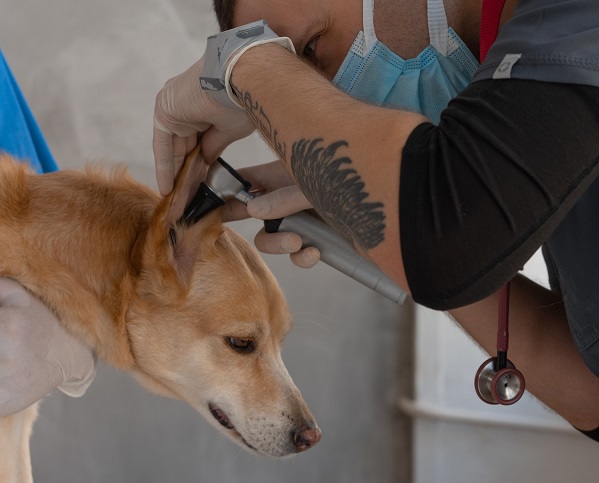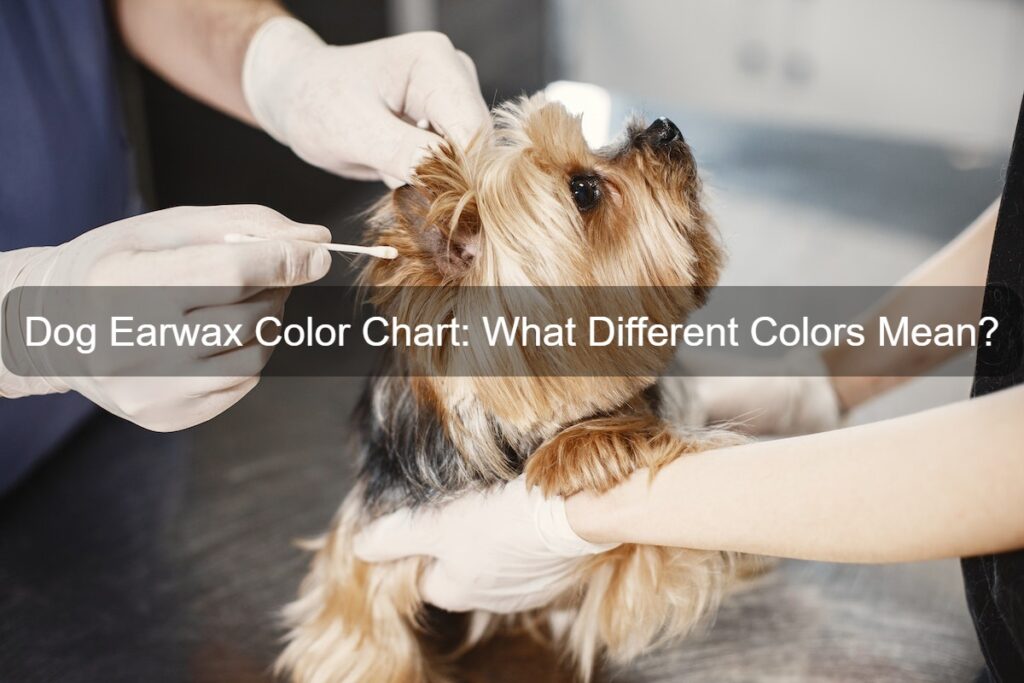Earwax is the natural secretion from the outer ear canal of dogs. It is composed of several components, such as cholesterol, glycerol, fatty acids, enzymes, and more. Mostly, dog earwax consists of dead skin cells and sebaceous secretions along with semiochemicals. Yes, you read it right – semiochemicals, are the chemicals that attract insects and microorganisms. No doubt, earwax blocks these germs and insects from entering the internal ear. Sometimes it may harbor their growth, resulting in infections.
Although producing earwax is normal for dogs, it can be problematic if there’s any change in its normal consistency and color. The color of the wax will vary depending on what elements are secreted in it. So, looking at its color can help you or your veterinarian diagnose a specific health issue with your dog. We have a simple dog earwax color chart in the next sections. It will help you understand what the different colors of earwax in dogs mean.
Why Do Dogs Have Earwax in Their Ears?
Well, their external ear canal has a lining made up of epithelial cells (ciliated cells). The cilia and earwax move along with warm air coming into contact with the ear canal. The wax traps any dust particles, insects, germs, pollen, and debris in the air. So, it basically works as a filter to keep the incoming air clean. Earwax also acts as an external waterproof coating. It thus prevents water from entering the ears when a dog goes swimming.
What Do The Different Colors Of Earwax Mean?

Are you wondering what the different colors of your dog’s earwax mean? Here’s all the information about different wax colors and what to do about them.
Yellow
In dogs, any shade of yellow wax with underlying pinkish skin indicates normal and healthy earwax. It means that the earwax is still fresh and has not picked up much debris. Healthy earwax should not have a runny consistency. It should also smell neutral.
Light Brown
According to vets, normal canine ear wax ranges from yellow to light brown in color. A light brown color means that the wax is a bit old and has accumulated some debris. There shouldn’t be any signs of swelling, redness, or an unpleasant odor for it to be healthy.
Dark Brown
Dark brown earwax, resembling the color of coffee grounds, is an indication of infection. The dog may have ear mites, parasitic issues, bacterial infections, or fungal infections. If you notice this color of earwax with a bad smell, it’s a good idea to contact a veterinarian.
Green
Green earwax in dogs is a true sign of severe bacterial, fungal, or yeast infection. The yeast or bacteria has overgrown in the ears, resulting in a green discharge. It is usually accompanied by an unpleasant odor. Other signs of infection are ear scratching, head shaking, discomfort, and swelling. We suggest you go visit your vet if you notice any of these signs along with green earwax.
Red
Red earwax in dogs is a sign of bleeding. It may be due to a number of reasons, like:
- An injury to internal air
- laceration of the ear canal
- Bug bite
- Rupture of the eardrum
- Severe infection
- Allergies
- Itchiness or pruritus
Whatever the reason may be, red earwax is not a good sign for your pup. You must take him to the vet as soon as possible.
Reddish Brown
A reddish brown earwax means your dog’s ear has been bleeding for some time now. The illness or injury is old and has previously caused bleeding. To find out if the bleeding has stopped or persisted up to this point, you should consult your veterinarian.
Gray
A little grey earwax with its usual consistency is nothing to worry about. Simply put, it indicates that your dog has been playing and rolling in mud. His earwax has become dirty due to picking up some mud. However, if it smells unpleasant and is more like a gray discharge than wax, there might be an infection.
Black
Earwax that is very dark or black in color is a sure sign of underlying infection, either bacterial, fungal, or parasitic. The dog may be suffering from ear mites. So, if you notice any black earwax, it’s a good idea to take your pet to the vet.
Dog Earwax Color Chart
Most people are well aware that earwax is yellow. But many of them don’t know what the different colors of a dog’s earwax mean. This can be really confusing for pet parents because it’s easy to forget some of these details. Our following dog earwax color chart will save you from confusion.
Earwax Color |
Meaning |
|
Yellow |
Normal and healthy ears |
|
Light Brown |
Normal and healthy ears |
|
Dark Brown |
Impacted ears: infection or ear mites |
|
Green |
Impacted ears: severe infection |
|
Red |
Bleeding ears: injuries, bug bites, or allergies |
|
Reddish Brown |
Bleeding ears |
|
Gray |
Maybe healthy or infected ears: Normal consistency = healthy but dirty ears, runny consistency = infection |
|
Black |
Impacted ears: severe infection or ear mites |
How to Clean Dog Earwax
It is common for most dogs to have an excess amount of wax in their ears. It can lead to a nasty buildup of earwax that can block your pet’s ears. So, it is important to clean your dog’s ears from time to time to avoid any problems.
You may follow these steps to clean your dog’s earwax at home. (If this is your first time cleaning up, don’t forget to see your veterinarian first.)
- Use a cotton ball dipped in an ear cleanser that your veterinarian recommends. Use it to gently wipe out the interior of the ear. Don’t go too deep.
- Squeeze the cotton ball to allow some cleaner into the ear. Massage ear bases to let the cleanser move through the ear. (If his ears are hurting or too irritated, avoid this step at all costs.)
- After you wipe out the cleanser, make your dog shake his head. You’ll be able to see if there’s some fluid left to be cleaned up.
- To make your dog comfortable after cleaning, treat him with his favorite snack.
Final Thoughts on dog earwax color
Earwax is a natural body phenomenon. But, its abnormal color and consistency are what make a pet parent worried. Understanding the colors of your dog’s earwax can help you determine if it’s something you should be concerned about or not. Save our dog earwax color chart for future reference. You can use it for the initial self-diagnosis of a health problem. But remember, it is not an alternative to a veterinary consultation.





